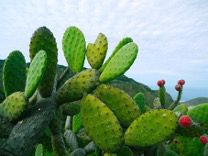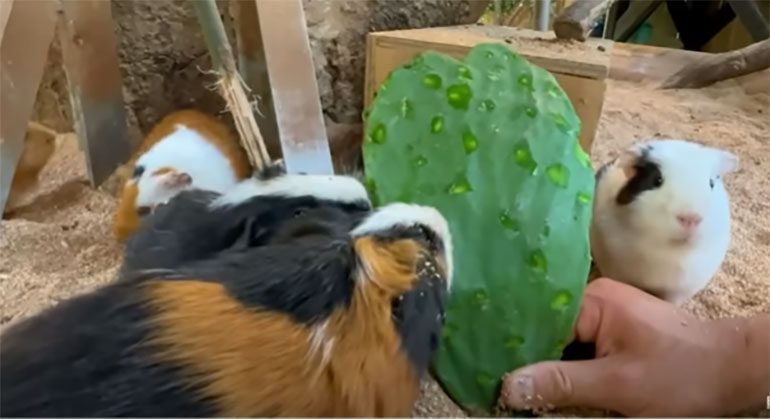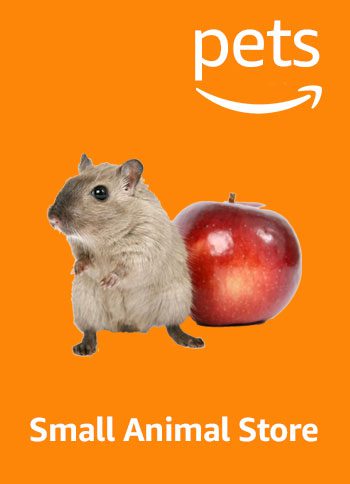Guinea pigs are herbivores, i.e., they only eat plant materials. Nutritionally, they require diets high in fiber and vitamin C and, as such, require foods containing these nutrients. Some of these foodstuffs are hay, fruits, and fresh vegetables. However, a common question many pet owners ask is if it is safe to feed their guinea pigs cactus. So let’s find out, “Can guinea pigs eat cactus?”
Yes, guinea pigs can and will eat cactus, but you shouldn’t feed them cactus all the time because cactus is high in sugar. If you constantly feed your guinea pigs cactus, they may end up getting diabetes. I’m sure you don’t want that for your furry piggies. You can feed them cactus as treats, maybe once or twice a week in tiny portions.
To really understand why pigs shouldn’t eat cactus, let’s dive a little into the nutrition of guinea pigs and the contents of the cactus plant. So take your time to read this article.
I assume that the cactus you’re probably referring to is the popular cactus pad or cactus pear, which is also called prickly pear. If I am right, then “yes,” guinea pigs can eat cactus; however, if you’re referring to other types of cactus, then it’s a little bit complicated.
First, what is a cactus? Cactus is a plant belonging to the Cactaceae family and contains several species—there are at least 1,750 known species of the cactus plant. Cactus are xerophytes which means they are adapted to very dry conditions with a lot of sun exposure. Cactus plants are known for their unique shape and spikes.
Are All Cactus Species Safe for Guinea Pigs?
Some species of the cactus plant, like cactus pads and cactus pears, are safe for guinea pigs to eat, but others are toxic and have the potential to cause harm to your piggies. It is therefore important to know the types of cactus plants that are safe for your guinea pigs and the ones that aren’t.
We will look at the common cactus plants available to see which ones are safe and which ones are not.
Safe Cactus Plants for Guinea Pigs

Opuntia: Opuntia is popularly known as prickly pear cactus or cactus pear and is safe for guinea pigs. This cactus is widely present in Mexico and the southern U.S., and it is widely used in human diets. Prickly pear cactus is very rich in vitamin C and fiber, which are essential for guinea pig health. It is also low in calcium, making it an ideal treat for guinea pigs.
Cactus Pads: It is safe to feed your guinea pigs cactus pads; nevertheless, before feeding it to your pet, make sure you remove the spines. Using gloves and a sharp knife is the best method to accomplish this. Similarly, it is necessary to cut the cactus pads into smaller pieces before feeding them to your guinea pigs. Spineless prickly pear cactus pads are also available at various pet stores and online.

Christmas cactus: The Christmas cactus, commonly known as Schlumbergera, is also safe for guinea pigs to eat. However, the Christmas cactus is not a substantial source of nutrients for guinea pigs; therefore, it should only be eaten in small quantities as a treat.
Toxic Cactus Plants That Are Not Safe for Guinea Pigs
Some species of cactus are not safe for guinea pigs. A good example is the peyote cactus; it contains a psychoactive substance called mescaline. When ingested by guinea pigs, it can cause vomiting, hallucinations and even death.
The Euphorbia cactus is another toxic cactus for guinea pigs, often known as the spurge. There is a toxic sap in this cactus that can cause serious skin and eye irritation. When consumed, your guinea pigs may experience vomiting, diarrhea and possibly death.
What Kinds of Nutrients Are Safe for Guinea Pigs?
When it comes to the nutrition of guinea pigs, a delicate balance is required. Nutrients like calcium, phosphorus, vitamin A and oxalic acid should be kept in low amounts.
Failure to adhere to this may cause some problems, for example, too much vitamin A can cause liver and kidney problems. Too much calcium may cause bladder stones and excess phosphorus will lead to phosphorus stones. Oxalic acid will lead to oxalate stones.
The daily vegetables recommended for your guinea pigs are lettuce, bell peppers, cilantro and zucchini.
Conclusion
Guinea pigs can actually eat some types of cactus plants. The majority of known, safe, cactus plants for guinea pigs are prickly pear and cactus pads. Some other species of cacti are very harmful to them and they should be avoided. While feeding your guinea pigs a cactus pad, it is very important to remove the spines and cut them into bite-sized pieces.





